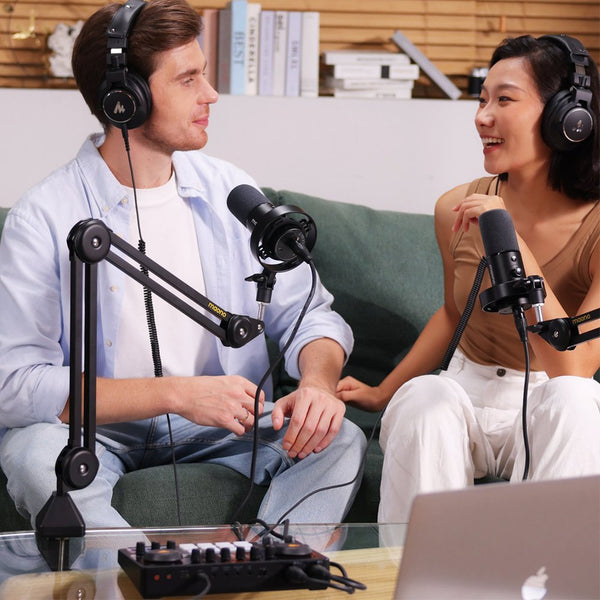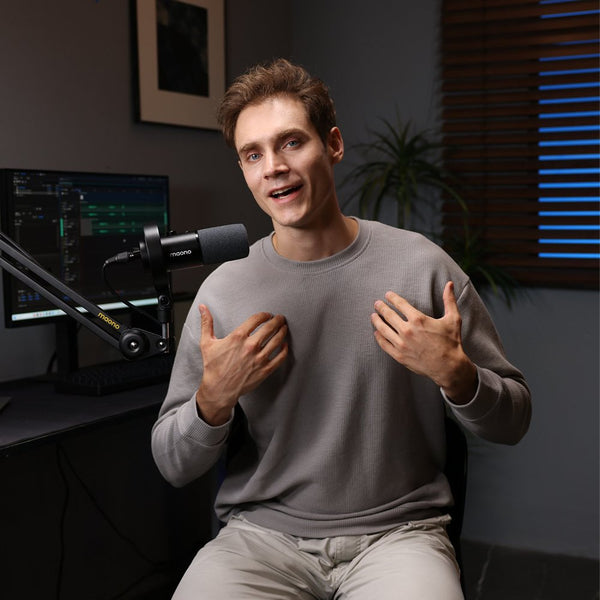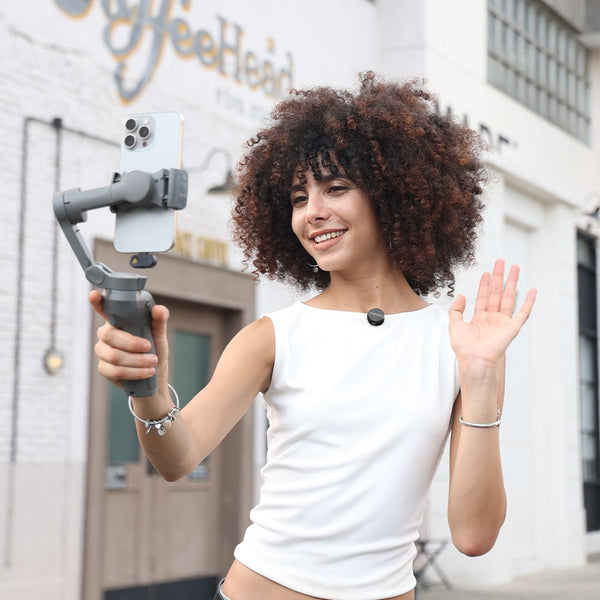Are you offering piano, guitar/violin, voice, or drum lessons?
Did you know that you can promote your services by posting a short video of yourself playing music with clear audio on Facebook?
How well your music and vocals sound depends on the quality of the condenser mic you use. Keep reading.
How to Record High-Quality Music Lesson Videos with a Condenser Microphone
In today’s digital world, musicians and music teachers are turning to social media platforms like Facebook to reach new students and share their expertise. Facebook videos, especially short, high-quality ones, are an effective way to showcase piano, guitar, and voice lessons to a broad audience. However, one crucial component that often gets overlooked is audio quality. That’s where a condenser microphone comes in.
Condenser mics are known for their sensitivity and ability to capture the nuance of vocals and acoustic instruments, making them ideal for music tutorials. In this guide, we’ll walk you through how to create professional-quality Facebook music lesson videos—from setup to recording tips—and recommend the top condenser mics for the job.
Best Facebook Video Tips for Promoting Piano and Voice Lessons
Creating engaging content on Facebook starts with understanding what keeps viewers watching. Here are some proven tips:
-
Hook Early
Capture attention in the first 3–5 seconds. Start with a musical demo or powerful statement like “Struggling with that high note? Let’s fix it now.”
-
Keep It Short
Aim for 60–90 seconds for quick tips or 3–5 minutes for mini-lessons.
-
Use Vertical Video
Facebook prioritizes vertical formats for mobile viewing.
-
Add Captions
Many viewers watch without sound initially. Use auto-captioning tools or apps like CapCut or Clips.
-
Include a CTA
Invite viewers to comment, follow your page, or book a lesson.
Setting Up Your Home Studio for Facebook Music Tutorials
You don’t need a full recording studio to create compelling content—just a few key elements can make a big difference:
-
Quiet Space: Choose a room with minimal background noise and good natural acoustics (avoid echoey, empty spaces).
-
Condenser Microphone: Place it on a boom arm or stand to reduce handling noise.
-
Pop Filter or Wind Screen: Helps eliminate plosives when speaking or singing.
-
Lighting: Use soft lighting facing you (ring light or natural light by a window) to look professional.
-
Background: Keep your background clean or decorate with musical elements to reflect your brand.
Voice Recording Tips for Vocal Coaches Posting on Facebook
If you’re a vocal coach, delivering clear and pleasant audio is essential. Here are specific tips for using a condenser mic:
-
Mic Placement
Keep your mouth 6–12 inches from the mic. Use a pop filter and speak or sing at a slight angle to avoid harsh consonants.
-
Monitor Your Levels
Use free software like Audacity or a basic audio interface to prevent distortion or clipping.
-
Room Treatment
Use curtains, rugs, or foam panels to reduce reverb and echo for cleaner vocal recordings.
-
Warm-Up Snippets
Share 30-second clips of warm-ups or vocal exercises to provide value and build credibility.
Top Condenser Microphones for Recording Music Lessons at Home
When selecting a condenser mic, consider clarity, sensitivity, and ease of use. Here are five top condenser mics for music lessons:
-
Maono PM450
User Review:
-
Best Features: Cardioid condenser mic, plug-and-play USB, wide frequency response (20Hz–20kHz), bundled with boom arm and pop filter.
-
Why It’s Great: Ideal for beginners and music educators; captures vocals and instruments with clarity and minimal background noise. Often, the Maono PM450 is considered the best condenser mic for vocals due to its balance and clarity.
-
Maono PM500
User Review:
-
Best Features: Studio-grade large diaphragm condenser mic, XLR connection, low self-noise, smooth vocal tone.
-
Why It’s Great: Perfect for serious vocal instructors or musicians looking for higher production quality, The Maono PM500 XLR condenser mic can amazingly be also used on live performances outdoors.
-
Audio-Technica AT2020
-
Best Features: Exceptional sound pickup, durable build, XLR model with great detail for voice and acoustic instruments.
-
Why It’s Great: A favorite for both home studios and semi-pro setups.
-
Blue Yeti USB Mic
-
Best Features: Multiple pickup patterns (cardioid, omnidirectional, bidirectional, stereo), easy USB setup.
-
Why It’s Great: Versatile for teachers switching between voice, piano, or group lessons.
-
Rode NT-USB
-
Best Features: Integrated pop filter, zero-latency monitoring, studio-quality resolution.
-
Why It’s Great: Combines ease of use with crisp sound, ideal for Facebook tutorials and live streams.
FAQ Section
Facebook Video Basics
-
What’s the best video length for Facebook music lesson posts?
60–90 seconds for tips; 3–5 minutes for lessons. Keep it short and value-packed. -
How can I make my Facebook music videos stand out in the feed?
Use engaging thumbnails, strong intros, and vertical format for mobile users. -
Should I caption my music lesson videos for better engagement?
Yes—many users watch without sound. Captions improve watch time and clarity. -
What editing apps are best for trimming and polishing music shorts?
Try CapCut, InShot, Adobe Premiere Rush, or iMovie for easy edits. -
How often should I post music lessons to grow my audience?
Consistency is key. Aim for 2–3 times a week to stay visible and build trust.
Knowing About Condenser Microphones
-
Why is a condenser microphone better for recording voice or instruments?
It captures a broader frequency range and more detail than dynamic mics, perfect for nuanced performances. -
What is the ideal distance from a condenser mic when singing or playing guitar?
Typically 6–12 inches for vocals; 6–18 inches for instruments depending on tone and volume. -
Do I need an audio interface when using a condenser microphone?
Yes, if you're using an XLR condenser mic. USB mics don’t require one. -
How do I reduce background noise when using a condenser mic?
Record in a quiet space, use a cardioid condenser mic, and reduce gain. Consider noise gates or filters in editing. -
What settings should I use for recording vocals with a condenser mic?
Start with low gain, flat EQ, and record in 24-bit if possible. Adjust depending on voice dynamics.
On Lesson Content:
-
What kind of music pieces attract more views for piano lessons?
Short, recognizable melodies (e.g., pop hits or classical favorites) draw more attention. -
How do I structure a short guitar tutorial for Facebook viewers?
Start with a demo, break down the part slowly, and summarize with a call to action. -
Should I teach scales, songs, or vocal warm-ups in short videos?
Mix it up. Scales show skill, songs attract viewers, and warm-ups provide real value. -
Can I use trending audio in the background of my own music lessons?
Yes, but ensure it complies with Facebook’s copyright policies or use royalty-free music. -
How can I make lessons fun and engaging for kids watching on Facebook?
Use colorful visuals, simple instructions, playful tones, and interactive questions.
Beginners Common Questions:
-
How do I connect a condenser microphone to my phone or laptop?
-
USB mics: Plug directly into laptops or phones (with OTG adapter).
-
XLR mics: Require an audio interface connected via USB to your device.
-
What’s the best lighting for recording music lesson videos?
Natural light or a ring light placed in front of you works best to reduce shadows and create a bright, clear look. -
Is it better to record Facebook videos live or pre-recorded for quality?
Pre-recorded videos usually offer better quality; live videos are good for engagement and Q&A sessions. -
How do I sync audio and video when recording separately?
Use a clap or marker at the start. Then sync waveforms in editing software like DaVinci Resolve or Adobe Premiere. -
What budget gear do I need to start filming quality music lessons?
-
USB condenser mic (like Maono PM450)
-
Phone tripod or stand
-
Ring light
-
Editing app
-
Optional: Audio interface for XLR mics and acoustic treatment, and headphones to listen to recording real time.
Conclusion
Recording high-quality music lesson videos for Facebook is easier and more accessible than ever—especially when you have the right audio setup. A condenser microphone is your best ally in capturing the rich tones of your voice or instrument and delivering them clearly to your audience. Whether you're teaching piano, guitar, or voice, combining a great mic with thoughtful lesson structure and smart video practices will elevate your content.
Start small, stay consistent, and focus on value—and soon, your music lessons will strike a chord with your Facebook followers.



